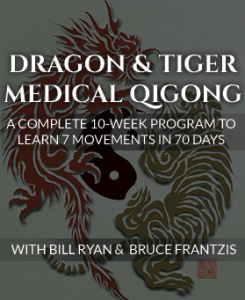By Susan Kansky
My Introduction to Qigong Tui Na
The first course I took with Bruce Frantzis was a weekly class in Qigong Tui Na (Chi Gung Tui Na) in San Francisco in 1989. I had a private practice in Palo Alto, California doing various kinds of Asian Bodywork Therapy at the time and I was studying Qigong in San Jose. I have been very curious about different healing modalities and energy development practices since I was teenager.
In Bruce’s classes I saw and experienced how quickly Qigong Tui Na can specifically target and release energy blockages throughout the body. I was impressed and immediately hooked. I went on to study the whole Qigong program and Tai Chi with Bruce. I have incorporated Qiogng Tui Na into my hands-on energetic bodywork practice ever since.
In my experience, Qigong Tui Na works well for a broad variety of physical, structural, stress related and energetic imbalances. I have many case examples to illustrate.
Experience Practicing Qigong Tui Na
Several years ago, I worked with a man who had fallen off an 80 foot scaffold and landed on concrete. He had pain throughout his body, despite completing a series of physical therapy sessions. I thought that Qigong Tui Na would be a good technique to use since it would help to reconnect the disturbed flow of energy at the core channel level that runs through the center of the joints and bones.
In a series of six sessions, the pain in his body moved progressively out of his body, moving from the torso out the five extremities of the hands, feet and head. Achiness and pain was released from his organs out the extremities as well. He felt pain-free after six sessions.
Once I worked with a man who limped into the office just minutes after breaking his leg. I started with above the body techniques based on Dragon and Tiger Qigong to balance out the flow of energy in the meridian lines. After about a minute, we heard a loud crack as his bone adjusted itself back into place. I then finished with pulsing the joints of the leg, first the ankle, knee and then hip to stabilize the core flow of energy in the leg. He walked out of the office with no limp and no pain.
Recently, I worked with a man who had badly broken his ankle 25 years earlier where the tendons had to be reattached. It was not much of a problem until recently. Doctors were suggesting ankle replacement surgery. He found that wearing shoes with cushioned soles helped a lot. I pulsed the ankle joint, clearing the stiffness in the affected quadrants of the joint. After one session of Qigong Tui Na, the mobility in the ankle joint tremendously increased to almost as much mobility as the other ankle. Before the session, the joint was very stiff and afterwards there was a lot of springiness in the ankle joint.
Combining Qigong Tui Na and Other Healing Modalities
When I lived in Scottsdale, Arizona I developed and directed a two-year degree program in Asian Bodywork, as well as 500-hour and 200-hour Qigong Tui Na, Zen Shiatsu, and Jin Shin Jyutsu acupressure diploma and certificate programs and a 100-hour Qigong program. I taught Qigong Tui Na for over 10 years primarily to Asian bodywork therapists, Ortho-Bionomyâ practitioners, massage therapists and lay people. Ortho-Bionomy is an osteopathic based structural and energy balancing system developed by a British osteopath.
My Asian bodywork students found that Qigong Tui Na and Zen Shiatsu blended very well together. My students would often use Qigong Tui Na for integration at the end of a session because Qigong Tui Na opens all the energy layers including the superficially located meridian lines, deeper spiraling pathways, and core channels in the joints and bones, thus stabilizing the changes throughout the whole system.
Pumping the limbs is a quick and easy technique to use for integration. Clients report deep relaxation during and after sessions because it relaxes the nervous system and opens the pathway for stress to release out the extremities.
My students and I have found that Qigong Tui Na complements the structural balancing techniques of Ortho-Bionomy really well. The unwinding techniques release the imbalances in the muscles, fascia, and connective tissues that pull the joints out of alignment. The pulsing techniques restore the spring, mobility, alignment and health of the joints, including the spine. Ortho-Bionomy or other bodywork techniques can be incorporated in a Qigong Tui Na session to clear tension from tight spots that would take longer to clear using the basic Qigong Tui Na techniques.
Simple Qigong exercises are great to teach clients to assist structural integration after the sessions. I usually teach simple components of Energy Gates Qigong movements that we learn as preparatory exercises to the complete movements of Energy Gates, such as kwa squats, or twisting or pumping the arms with the arms parallel.
I have a good sense of how Qigong Tui Na compares with other healing modalities because I have studied many different styles of bodywork and energy-work and experienced many more as a receiver. The Western bodywork systems I have seen focus on systems of the body separately, such as the myofascial system, cerebrospinal system, structural alignment and posture, acupuncture meridian system, nervous system, mobility of the joints, or internal organs.
What I find unique about Qigong Tui Na is the way it clears patterns from the muscles, fascia, connective tissue, tendons, ligaments, nerves, joints, internal organs, meridian lines and core energetic levels all in one session with one integrated comprehensive system. I often do some Qigong after a Western bodywork session to integrate the effects of work on that one system within the whole. As a result, I find that the results of the session last longer.
Learning Qigong Tui Na
If you are interested in learning Qigong Tui Na I recommend also learning Qigong to develop your ability to feel energy more sensitively and to have a way of clearing yourself between clients. Dragon and Tiger Qigong is a good place to start. It is excellent for quickly improving your ability to feel energy deep inside the body and in the energy field. It is also a wonderful set to do between clients to keep your energy level higher than your clients and to clear out any unwanted energy you may have picked up. Dragon and Tiger Qigong is excellent for energy workers, acupuncturists, body workers, psychotherapists and physicians to prevent practitioner burnout.
I have found my Qigong Tui Na and Qigong practice complement each other well. Progress I make in my Qigong practice shows up in my Qigong Tui Na sessions as a greater ability to feel subtle imbalances and quicker results. The awareness of internal blockages and how various areas of the body interrelate has increased my internal awareness in my own Qigong practice. I also am better able to help my Qigong students with their specific issues.
Susan Kansky has 7,500 hours of training in Asian Bodywork, Energy Medicine, and Chinese health exercises. She has been teaching Chi Gung and Asian bodywork since 1986.





0 Comments